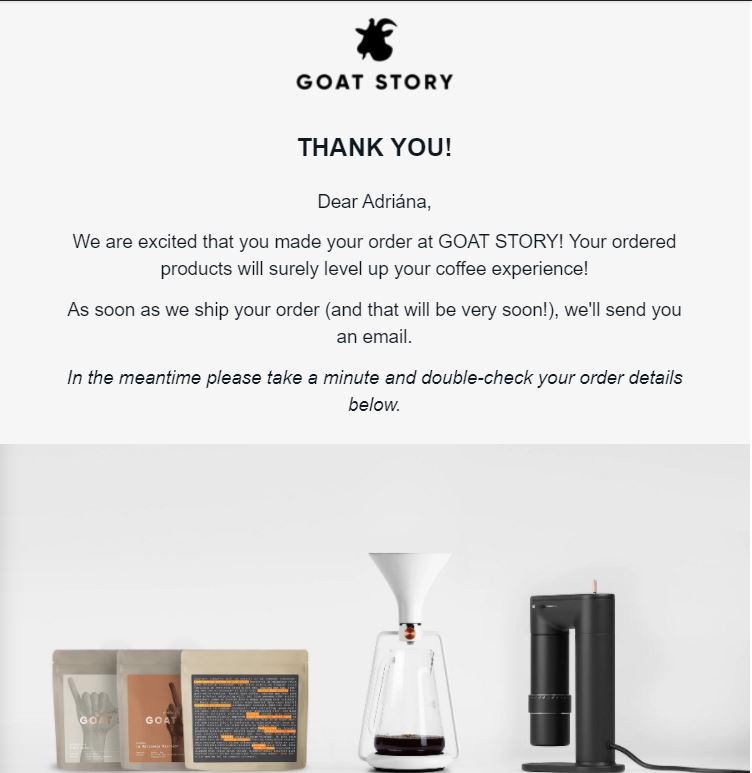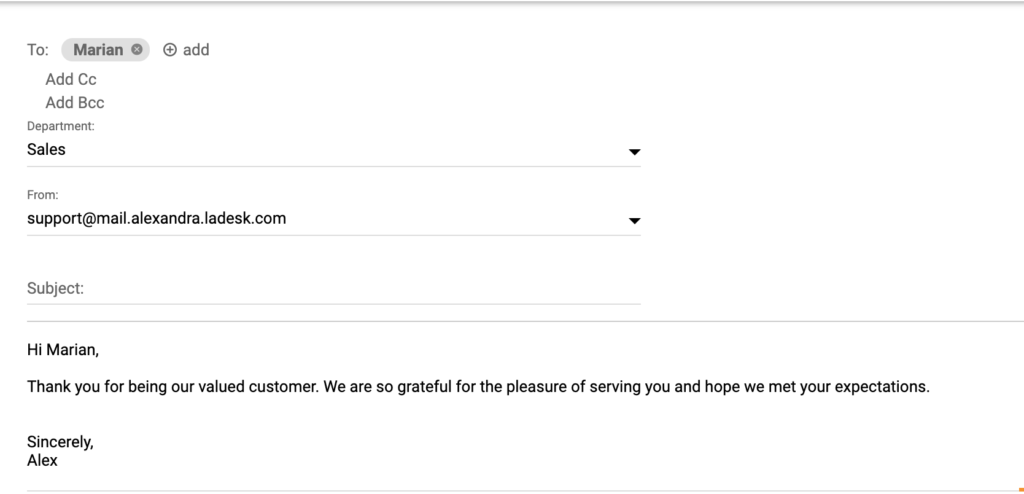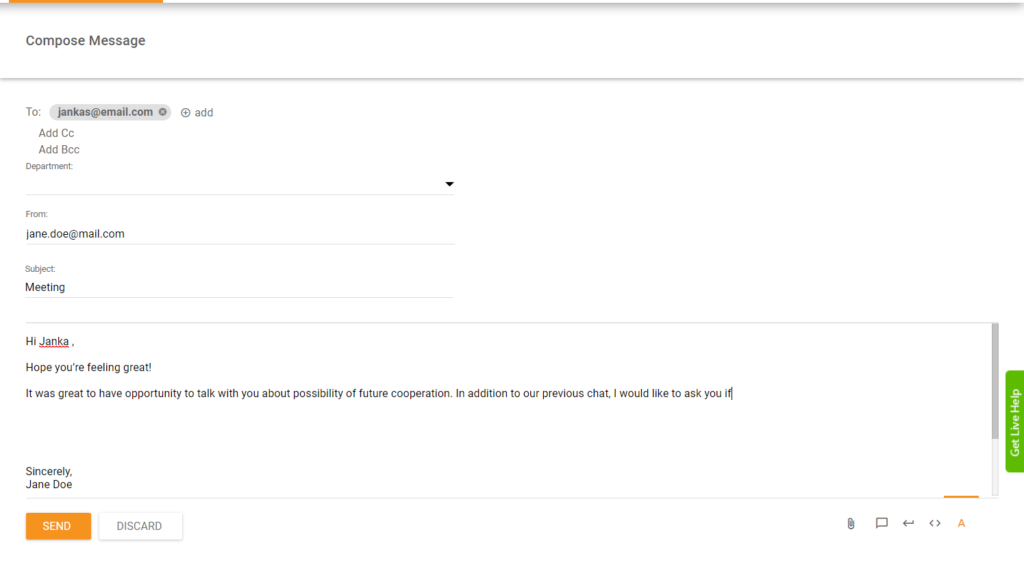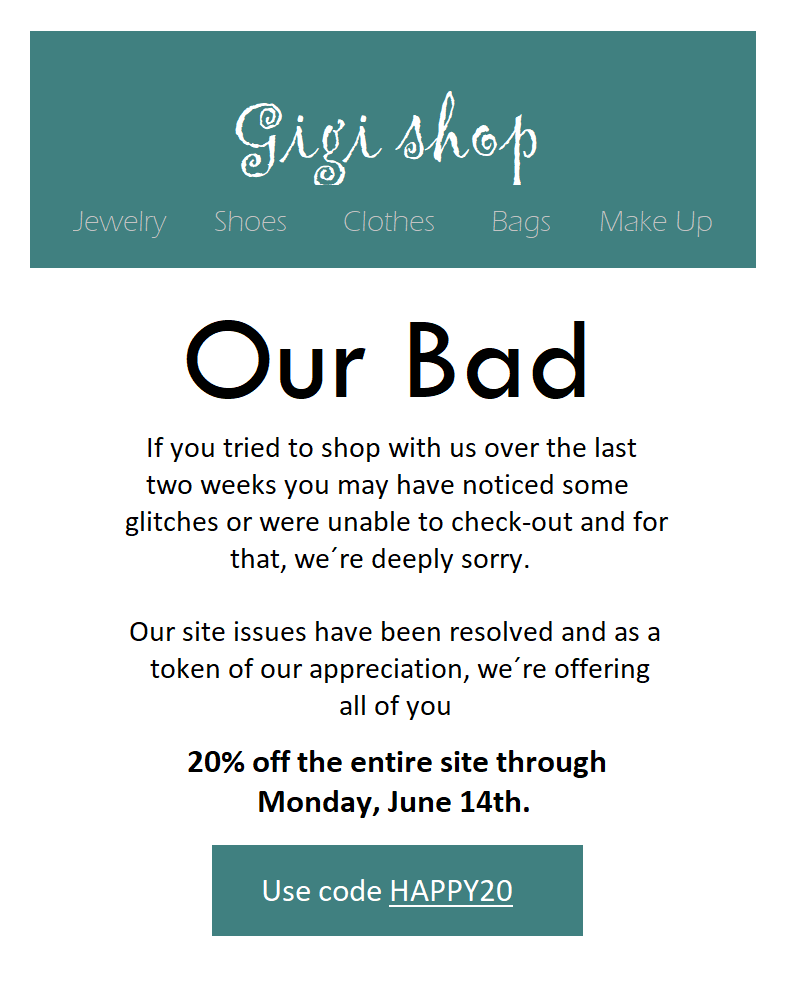- EuropeAsieMoyen Orient
- Modèles d'emails
- Comment commencer un courriel (Conseils + modèles)
Comment commencer un courriel (Conseils + modèles)
Découvrez des conseils et modèles pour débuter un courriel professionnel en français. Inclut des salutations adaptées pour les ventes, le service client, et plus, afin d'engager efficacement vos destinataires et éviter que vos emails soient ignorés.

Avec plus de 300 milliards d’emails envoyés et reçus chaque jour, l’email est un moyen de communication essentiel. Trouver comment commencer un courriel d’affaires de façon professionnelle – surtout lorsque vous écrivez à quelqu’un que vous ne connaissez pas – peut être un défi pour les spécialistes du marketing, les vendeurs et les représentants du service à la clientèle.
En fait, la façon dont vous commencez votre email peut faire la différence entre votre destinataire qui ferme l’email tout de suite (et le supprime) ou qui continue à lire. L’article suivant fournit quelques conseils sur la façon de commencer un courriel ainsi que certaines des salutations et des amorces de courriel les plus courantes que vous pouvez utiliser dans votre correspondance professionnelle.

Ce qu’il faut inclure au début de vos courriels
1. Salutation ou accueil
Commencez par une formule de salutation appropriée, en fonction du degré de formalité dont vous avez besoin. Indiquez toujours le nom du destinataire (si vous le connaissez) pour rendre la salutation plus personnelle. Enfin, vérifiez que vous avez correctement orthographié le nom du destinataire. Notre conseil de pro ? Copiez et collez leur nom tel qu’il a été vu dans des courriels précédents, des signatures de courriel ou des sites Web pour vous assurer que vous ne faites pas de faute de frappe.
2. Introduction et raison de la rédaction (si nécessaire)
Lorsque vous écrivez à quelqu’un pour la première fois, présentez-vous et incluez une phrase concise sur l’objectif de votre courriel. Cette phrase peut déterminer si le destinataire va lire votre courriel ou l’ignorer, alors assurez-vous que votre objectif est clair et convaincant.
Si vous avez des amis, des collègues ou des connaissances en commun, mentionnez-les car cela peut augmenter vos chances d’obtenir une réponse. Par exemple, vous pourriez faire un name drop subtil comme ceci : “Bonjour [Nom], j’ai croisé notre ami commun Richard (de [Entreprise]) ce week-end et il m’a dit que vous aviez besoin d’un nouvel outil de help desk, car votre fournisseur actuel ne fait plus le poids…”.
3. Une phrase d’ouverture/des vœux (facultatif)
Si vous n’avez pas écrit au destinataire depuis longtemps ou si vous avez une relation occasionnelle avec lui, il serait approprié d’inclure une note rapide et positive comme “J’espère que vous allez bien” Cela peut donner le bon ton pour le reste de votre courriel.
Sinon, si le destinataire a partagé quelques mises à jour sur LinkedIn ou d’autres médias sociaux, n’hésitez pas à le féliciter pour ses dernières réalisations (tant personnelles que professionnelles). Vous pourriez dire quelque chose comme “Félicitations pour votre promotion” ou “Félicitations, c’est excitant de voir [l’entreprise du destinataire] acquérir un client aussi important que [l’entreprise]” .
4. Une ligne de remerciement (facultative)
En fonction du contexte, vous pouvez ajouter une courte ligne de ” remerciement ” à votre correspondance électronique. Par exemple, si votre prospect/client vous a contacté pour une demande de renseignements, “Thank you for reaching out” ou “Thank you for contacting [Company]” est incontournable. Cependant, chaque fois que vous mettez une note de remerciement, il est important de la personnaliser, car les notes de remerciement standard (comme celles mentionnées ci-dessus) sont un peu trop génériques et peuvent paraître froides ou distantes.
En ajoutant simplement un nom avant votre ligne de remerciement, le message semble plus chaleureux et invitant. Voici un exemple : “Emily, merci beaucoup d’avoir contacté [Entreprise] et d’avoir soulevé cette question. Vous avez tout à fait raison…”
.

Exemples et modèles pour commencer un courriel
Messages d’accueil professionnels par courriel
“Bonjour [Nom]” est probablement la salutation de courriel la plus courante et la plus utilisée dans le monde des affaires. Cette salutation est généralement recommandée pour les styles de communication semi-formels et informels. Si vous souhaitez être légèrement plus formel, “Bonjour” peut être remplacé par “Salut.”
“Cher [nom]” est également approprié pour les communications formelles et informelles. Pour vous faciliter la tâche, nous avons préparé toute une liste d’autres salutations génériques parmi lesquelles vous pouvez choisir pour commencer votre courriel professionnel. Consultez-les :
Lorsque vous écrivez à un ou deux destinataires :
- Cher [Nom],
- Cher [Nom] et [Nom],
- Bonjour [Nom],
- Salut [Nom],
- [Nom],
- Hey [Nom],
Lorsque vous écrivez à trois destinataires ou plus :
- Bonjour tout le monde,
- [Nom du groupe ou de l’équipe],
- Bonjour l’équipe,
- Bonjour tout le monde,
- Bonjour là-bas,
- Bonjour,
- Bon après-midi,
- Bon soir,
Lorsque vous n’êtes pas sûr du nom du destinataire :
- Cher Monsieur,
- Cher Madame,
- Hi,
- Bonjour,
- Vœux,
- Chère directrice du recrutement,
- Chère équipe de recrutement,
Phrases d’ouverture générales des e-mails
Après la salutation, vous pouvez inclure une courte phrase d’ouverture pour donner le coup d’envoi de votre courriel. Cependant, il est préférable d’éviter des phrases comme celles-ci si vous écrivez un email formel ou si vous envoyez un email à froid à un client potentiel, car elles peuvent paraître trop amicales. Voici quelques-uns des exemples les plus courants d’ouvreurs d’email :
Hope this email finds you well.
I trust you are doing well.
How’s it going at [Company name]?
It’s great to hear from you.
I’m pleased to hear that…
I hope you enjoyed your weekend.
Hope you’re enjoying your holiday.
I hope you had a great trip.
I hope you’re doing well.
Hope you’re feeling great!
I hope you’re having a great week.
I hope you’re having a wonderful day.
I hope you enjoyed the event.
I hope you enjoyed your vacation.
I’m reaching out about…
I’m wanted to ask about…
I just wanted to send you a brief note about …
Congratulations on [recent accomplishment].
How did [recent project/ event] turn out?
I loved your recent [article/social media post].

Phrases d’ouverture des courriels de suivi
Si vous n’êtes pas sûr de ce que vous devez écrire au début de votre courriel de suivi, pensez à inclure l’une des phrases d’ouverture de courriel suivantes qui peuvent briser la glace :
As we discussed in our phone call …
As we discussed at our meeting …
As promised, here’s …
I’m checking in on …
Just checking in to make sure that …
Following up on our meeting …
I am writing to follow up on…
I’m getting back to you about…
This is just a quick note to…
This is just a quick reminder…
I wanted to let you know that…
Can you please give me an update on …
I’m writing to remind you about…
It was great to meet you at [event].
It was great talking to you last week.
I’m glad we had a chance to chat at the [event].
It was a pleasure to meet you yesterday.
Phrases d’ouverture des e-mails de réponse
Lorsque vous répondez à un client ou à un prospect, une courte ligne de “Merci” est appropriée dans de nombreux cas. Si vous ne savez pas comment intégrer un “Merci” ou si vous avez besoin de plus d’inspiration, consultez quelques-unes de nos alternatives :
Thanks for getting in touch.
Thank you for your message.
Thank you for letting me know.
Thank you for the update.
Thank you for the heads up.
Thanks for keeping me in the loop.
Thanks for the quick response.
Thank you for taking the time to [write to us/give us your feedback].
Thank you so much for getting back to me.
Thanks for getting back to me so quickly.
Thanks for your feedback on …
I’m sorry it took me so long to get back to you.
I apologize for the late response.
I’m sorry it’s been so long since my last email.
Sorry for my late reply.
Could you please clarify [something]?
Could you explain what you mean by [something]?
Could you give us some more details on…?
Comment commencer un courriel de vente à froid
Lorsque vous écrivez un email froid à un prospect, le premier paragraphe va déterminer si votre prospect trouvera que votre message vaut la peine d’être lu, il est donc important d’impressionner et de se démarquer. Voici quelques exemples de ce que vous pouvez inclure dans votre paragraphe d’introduction :
“My name is [Name], and I am the marketing director for [Company]. [Mutual connection] recommended that I get in touch with you regarding …”
“My name is [Name], and I’ll keep this quick. I’m the founder of a software tool that helps businesses like yours achieve [specific goals] through [product benefits].”
“My name is [Name] and we work with companies like [Company 1], [Company 2], and [Company 3] to improve their [sales/ marketing efforts/ customer service, etc.].”
“[Name] from [Company] here. I saw you recently [visited our website/ downloaded a whitepaper, etc.]. I’ve worked with similar companies in [field/ industry] and I thought I’d reach out.”
“My name is [Name] and I’m with [Company]. We have recently launched a new solution that [what your solution does]. Based on your online profile [profile link], it appears that you might be the right person to talk about [problem solved by your product].”
Si vous souhaitez en savoir plus, consultez les modèles d’e-mails de vente à froid.
Comment lancer un courriel de suivi des ventes
Le suivi d’un prospect, surtout s’il n’a pas répondu à votre ou vos messages précédents, peut être délicat. Si c’est le cas, essayez l’une de ces phrases d’ouverture d’email efficaces… elles pourraient vous être utiles !
“I trust that you have had an opportunity to read my previous email and look at our website, so I figured it’d be worth checking in with you again.”
“I sent you an email a while ago about [Company] and how I think we could be a great fit for you and [Company]. Did you know that our clients report [a **% increase] in [sales] when they use our [software/ platform/ tool]?”
“I hope I’m not overstepping, but I see that you have read my previous email and visited our site (the wonders of modern technology). I think this will be a good time for us to take the conversation further. What do you think? Are you available for a quick call on [date and time]?”
“I know how busy you must be managing your team and helping them increase [job function]. I sent you some information about [Product] a while ago and I thought this might be a good time to give you a practical demonstration.”
“I’m writing to follow up on my email as I didn’t hear back from anyone on the team. As I stated in my previous message, I believe [Product] can greatly improve how you do [what your product helps with].”
Si vous souhaitez en savoir plus, consultez les modèles d’e-mails de suivi des ventes.
Design your own templates
LiveAgent gives you the power to design your own customer email templates, thus helping you to improve the customer service. Curious about all the opportunities?
Comment créer un courriel de bienvenue après achat ou pour le client ?
Chaque fois qu’une personne achète votre produit ou s’inscrit à votre service, vous devez la remercier ou lui souhaiter la bienvenue dans la ” famille ” pour que votre relation démarre sur les chapeaux de roue. La meilleure façon de le faire est d’écrire un courriel de bienvenue qui comprend un mot de remerciement, une courte introduction et toute information utile.
“Thank you for your recent purchase with us! I hope you’re enjoying your [product/ service].”
“Welcome to [Company]! We’re feeling pretty lucky that you chose us, and I just wanted to say thank you on behalf of our whole company.”
“I’m [Name], the founder of [Company] and I’d like to personally thank you for signing up for our service.”
“Welcome to [Product/ Company]. We’re thrilled to see you here! I’ll be your guide during this onboarding period, and my goal is to ensure you have a positive experience and get the most out of our [product/service].”
“Welcome to [Brand]! We’re excited to have you on board and we can’t wait for you to start using [product/ service] and seeing results.”
N’hésitez pas à consulter d’autres modèles d’emails post-achat et modèles d’emails de bienvenue.
Comment lancer un courriel de service à la clientèle
Presque tous les e-mails du service client doivent commencer par une note de remerciement, qu’il s’agisse de répondre à une simple demande du service client ou de répondre à une plainte d’un client. Voici à quoi cela peut ressembler :
“Thanks for reaching out! I’d be more than happy to help you.”
“Thank you for contacting [Company]. My name is [Name] and it would be my pleasure to assist you with …”
“Thank you for writing to us today. I’d be happy to answer those questions for you …”
“Thank you for your inquiry about […]. I’m really sorry to hear that you can’t […] I’m escalating your issue so that someone can take a closer look at what’s going on right away.…”
“Thank you for writing in. This message is to confirm that we’ve received your request, and will be in touch within ** hours with a complete response.”
Si vous souhaitez en savoir plus, consultez les modèles de service à la clientèle.
Comment lancer un courriel d’excuses pour un client
Lorsque vous répondez à des clients en colère ou mécontents, veillez à faire preuve d’empathie et à présenter des excuses au nom de votre entreprise. Voici comment vous pouvez le faire :
“Thanks so much for reaching out about order #[number]. I’m so sorry the product hasn’t worked out for you.”
“I’m so sorry that you had a negative experience with [product/ service/ company department]. I’ve looked into the issue, and it seems that [briefly explain the reason for their bad experience].”
“I am so sorry to hear that you have had such a poor experience with us. Although we strive for 100% customer satisfaction, it’s clear we’ve fallen short in this instance – and that’s unacceptable.”
“I am so sorry to hear that [a brief summary of their bad experience]. That should have never happened, and I completely understand how frustrating this must be for you.”
“Thank you for providing us this feedback. I realize how frustrating it must be to [details of the issue]. We obviously failed this time, and for that, we are very sorry.”


LiveAgent allie un excellent chat en direct, un logiciel de ticketing et l'automatisation qui nous permettent de fournir un excellent service client à nos clients.
Regardez comment rédiger des e-mails en anglais – formel, semi-formel ou informel

hi everybody and welcome back to english. for professionals i'm derek and i'm here. with another short lesson for you busy. people in this business english emails. lesson i'm going to show you the. differences between formal. semi-formal and informal emails. [Music]. before we get started if you need. english for work and you're interested. in short lessons to help you with your. business english then subscribe to my. channel now hit the red button and don't. forget to click on the little bell that. way you'll be notified every time i. upload a new lesson and now. let's get started. we're going to do three things in this. lesson. first of all we'll talk about the. different kinds of people we write. emails to and we'll categorize them into. formal semi-formal and informal after. that i'll show you example emails in. each style and at the end of the lesson. i'll show you lots of extra example. phrases in each style. let's start with formal emails we. usually use a formal style when we write. to new customers suppliers and business. partners and also to people who are in. higher positions managers bosses and. directors. we usually use a semi-formal style with. colleagues we know but not very well and. also with existing customers suppliers. and business partners. we use an informal style when we write. to friends and family and also to. colleagues or business partners we know. very well and work with on a regular. basis. the most common style to use in business. is the semi-formal style but of course. there are exceptions. for example it's quite possible that we. could use an informal style to write to. a customer or a supplier but only if we. know that person very well and if we. have a good and long relationship with. them and one more thing the style you. use also depends on the culture in your. company as well as the business culture. in the countries you work within so you. need to be aware of those factors. and now it's time to look at some. examples we'll start with the formal. style and the email we're going to look. at is a follow-up email after a formal. business meeting with a potential new. business partner. we start with a formal greeting dear. miss amir. first of all i would like to thank you. for the productive meeting on monday it. was lovely to meet you and learn more. about your business here we have formal. phrases like i would like to and it was. lovely to meet you. as discussed in the meeting i am sending. you the additional information about. that you requested i have attached a. document with all of the details and. here we have more examples of very. formal phrases as discussed in the. meeting. that you requested and so on if you. require any further information please. do not hesitate to contact me again a. typical formal style. i look forward to our next meeting on. january 10th. best regards derek callum. i look forward to and best regards our. typical phrases we use to close a formal. email. so there we have the formal style now. let's compare that one to a semi-formal. version of the same kind of email. in this case it's a follow-up email. after a less formal meeting with a. potential new business partner and as. you'll see in a moment we're already. using first names. dear nidra first of all i just wanted to. say thanks for the productive meeting on. monday it was great to meet you and find. out more about your business so here you. can already see a big difference first. of all first names so imagine that first. meeting was less formal and by the end. of the meeting we were using first names. also in that first line we don't have. the i would like to we have i just. wanted to say. and also rather than saying it was. lovely to meet you and learn more about. your business we have the less formal it. was great to meet you and find out more. about your business. i've attached a document with the extra. information about. that you asked for here we see more. examples of a less formal style instead. of i have attached we use the short form. i've attached we don't use words like. additional information or that you. requested we use less formal style extra. information. that you asked for. and now let's look at the last part of. the email please let me know if you need. any more information looking forward to. our next meeting on january 10th regards. derek so again much less formal. please let me know instead of the very. formal please do not hesitate to contact. me if you need any more information. instead of if you require any further. information and also in the closing part. looking forward to instead of i look. forward to. and then we have regards which is. slightly less formal than best regards. so there we can see the differences. between the very formal and the. semi-formal. and as i said before the semi-formal is. the one we use most often in business. correspondence but of course as i said. earlier it always depends on who you're. writing to company culture the business. culture those are things you need to be. aware of. now let's take a look at the comparison. between the semi-formal and the informal. style. this time we have another follow-up. email but it's after a very informal. meeting with a colleague you know very. well. hi tom just a quick mail to say thanks. for the meeting on monday and to send on. that extra info you asked for. see attachment. the first difference we can see here is. in the greeting hi tom hi is less formal. than. deer and then also in the start of that. first sentence just a quick mail to say. this is a typical way to start an. informal email. when you're giving someone information. and then we also have phrases like to. send on that extra info very informal. let's continue if you need anything else. just get in touch so again very formal. expression here just get in touch. see you at the next meeting cheers derek. so typical way to end an informal email. see you at the next meeting. cheers cheers can mean goodbye it can. also mean thank you this is just one. possibility if you want to see more ways. to end an informal email check out my. other lesson. 17 ways to end an email. now it's time for the last part of the. lesson where i show you more examples of. typical email phrases for formal. semi-formal and informal emails. let's start with friendly openings it's. often a good idea to use one of these. after you're greeting and before you say. why you are writing. i hope everything is going well. semi-formal. i hope all's well. and in the informal version. hope all's well or nothing we don't. always need to include a friendly. opening especially to people who we are. writing to on a daily basis or who we. write to. very often. and now an example for saying why you. are writing. i am writing to update you on. semi-formal i just wanted to update you. on. and in the informal version. just wanted to keep you in the loop on. keep you in the loop is a very informal. phrase which means to keep somebody. informed about the latest information. about something. requests. formal style. would it be possible too. semi-formal. is there any chance you can. and the informal can you. making arrangements. i was wondering if you would be. available for a meeting next. semi-formal would you be available for a. meeting next. and informal. can we meet next. confirming arrangements i would like to. confirm our meeting. just want to confirm our meeting. i'll be there. giving information i am afraid i will. not be able to. i'm afraid i won't be able to. and sorry but i won't make it to. and one more example closing line. referring to next contact. i look forward to hearing from you soon. looking forward to hearing from you soon. and. talk to you soon. so that brings us to the end of another. short lesson i hope you liked it and i. hope you found it helpful don't forget. to check out all of my other email. lessons here on youtube. i'll leave a link in the description if. you did like the lesson hit the like. button and share with your friends and. colleagues subscribe to my channel if. you haven't done that and don't forget. to join my email list every two weeks i. send out my free vocabulary email with. additional business english words in the. news and everyday english for you to. learn the link is also in the. description below thanks a lot for. watching and talk to you soon.
Résumé
Le début de votre message professionnel (le message d’accueil, la ligne d’ouverture et la première phrase) est la première chose que le destinataire voit lorsqu’il ouvre votre message. En commençant votre message de manière professionnelle, vous avez plus de chances de créer une impression positive sur lui. La formule de salutation que vous utilisez et les premières phrases que vous choisissez pour le début de vos e-mails professionnels dépendront de votre public et du contexte de votre communication. Utilisez les salutations et les phrases d’ouverture d’e-mail mentionnées ci-dessus pour vous guider lorsque vous ne savez pas comment commencer votre prochain e-mail à un client ou à un prospect.
N’oubliez pas de vérifier que vos messages ne contiennent pas de fautes d’orthographe ou de grammaire, et veillez à toujours orthographier correctement le nom du destinataire. Notre dernier conseil est de faire court, car personne n’a envie de lire de longs messages. Allez droit au but en utilisant le bon ton de voix et le tour est joué.
Master the art of starting emails with LiveAgent's how-to-start-an-email templates.
Our expertly crafted templates provide you with effective and attention-grabbing opening lines that will engage your recipients from the get-go.
Découvrez le concept de "domaine e-mail externe" avec LiveAgent, un outil révolutionnaire pour améliorer votre service client. Apprenez comment une adresse e-mail associée à votre entreprise renforce la confiance et l'autorisation. Essayez LiveAgent gratuitement pour optimiser votre communication et augmenter la satisfaction client.
Signature de l’Agent (Explained)
Découvrez comment personnaliser la signature de l'agent dans LiveAgent pour ajouter une touche professionnelle à vos interactions client. Améliorez la satisfaction client avec des fonctionnalités avancées et un essai gratuit de 14 jours. Rejoignez notre communauté d'utilisateurs satisfaits et optimisez votre service clientèle dès aujourd'hui !
Découvrez une gamme complète de check-lists sur LiveAgent pour optimiser vos processus métiers, du service client au marketing. Simplifiez vos tâches et atteignez l'excellence opérationnelle avec nos guides détaillés, adaptés à divers secteurs comme les centres d'appels, la conception graphique, et bien plus encore. Visitez notre page pour transformer vos défis en succès.
Découvrez le chat instantané, un outil de messagerie en temps réel essentiel pour améliorer votre service client. Apprenez à l'installer sur votre site, et explorez ses fonctionnalités avancées, comme les appels vidéo et le partage d'écran. LiveAgent vous offre une solution complète pour booster l'engagement client. Essayez-le gratuitement dès maintenant et propulsez votre service clientèle vers de nouveaux sommets!
You will be
in Good Hands!
Join our community of happy clients and provide excellent customer support with LiveAgent.

Notre site web utilise des cookies. En continuant, nous supposons que vous avez l'autorisation de déployer des cookies, comme indiqué dans notre site Web. politique de confidentialité et de cookies.

 Български
Български  Čeština
Čeština  Dansk
Dansk  Deutsch
Deutsch  Eesti
Eesti  Español
Español  Ελληνικα
Ελληνικα  Hrvatski
Hrvatski  Italiano
Italiano  Latviešu
Latviešu  Lietuviškai
Lietuviškai  Magyar
Magyar  Nederlands
Nederlands  Norsk bokmål
Norsk bokmål  Polski
Polski  Română
Română  Русский
Русский  Slovenčina
Slovenčina  Slovenščina
Slovenščina  简体中文
简体中文  Tagalog
Tagalog  Tiếng Việt
Tiếng Việt  العربية
العربية  English
English  Português
Português 


